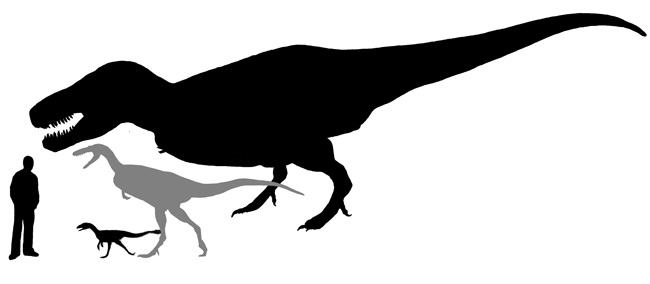T. Rex Relative Fills Evolutionary Gap

A Tyrannosaurus rex ancestor and an ostrich-mimic have emerged as two new dinosaur species found among a treasure trove of skeletons in China's Gobi Desert.
The T. rex relative had a mouthful of 70 teeth, and stood 5 feet tall at the hip while weighing almost a third of a ton. Scientists say that its discovery helps fill in a "missing link" in the giant carnivore's evolution.
However, the earlier dinosaur "was still a fly weight predator compared to its heavy-weight relatives," said Peter Makovicky, curator of dinosaurs at the Field Museum in Chicago. The Field Museum houses the largest known T. rex specimen, named Sue, which stood at nearly 14 feet tall at the hips and weighed between 6 and 7 tons.
Fills a big gap
Such large tyrannosaurs represent the later evolutionary killing machines in the family, and scientists have also found the earliest tyrannosaurs from China and England. The new relative helps fill in a large gap between the early and late chapters of tyrannosaur evolutionary history.
Chinese and American scientists who found the T. rex ancestor named it Xiongguanlong baimoensis, with Xiong Guan meaning "grand pass" and long being the Mandarin word for dragon.
"Xiongguanlong sheds light on the missing 40 [million] to 50 million years of tyrannosaur evolution," said Mark Norell, a paleontologist at the American Museum of Natural History in New York.
Sign up for the Live Science daily newsletter now
Get the world’s most fascinating discoveries delivered straight to your inbox.
The new dinosaur stands out from its late tyrannosaur family by having a very long and narrow snout, rather than the wide, massive skull of T. rex built for powerful bites. But Norell noted that it possessed body features which reveal the tyrannosaur evolution from small and mid-sized predators to top predators, including modified "nipping" teeth at the front of its mouth and expanded vertebral structures to support a larger head.
The team also found the new ornithomimosaur, or ostrich-mimic dinosaur, called Beishanlong grandis. Beishanlong weighed an estimated 1,400 pounds and rivaled the late Cretaceous ornithomimosaur called Gallimimus in size.
Still growing
Perhaps most surprising, the Beishanlong specimen had not finished growing yet when it died millions of years ago. Researchers analyzed a cross section of a lower leg bone to determine the dinosaur's age.
"Growth line counts revealed that the animal perished during its 14th year of life," said Gregory Erickson, a paleobiologist at Florida State University. "Although it is hard to fathom, this giant was still actively growing when it died."
Other finds from the Chinese-American expeditions show evidence of environmental separations among different kinds of dinosaurs. Horned dinosaurs and sickle-clawed dinosaurs tend to dominate red rocks deposited under dry conditions across almost all Cretaceous localities in the Gobi Desert, whereas tyrannosaurs, ornithomimosaurs, and duck-billed dinosaurs tend to occur in rocks deposited in wetter environments.
"The abundance of new dinosaurs from Chinese localities like the Yujingzi Basin, allows us to study the long history of dinosaur evolution in light of both geographic and environmental parameters in a way that is impossible elsewhere in the world," said Gao Ke-Qin of Peking University in Beijing.
The full study is detailed online this week in the journal Proceedings of the Royal Society B.
- Dinosaurs: News and Information
- Video - Finding the 'Leonardo' Fossil
- Avian Ancestors: Dinosaurs That Learned to Fly










